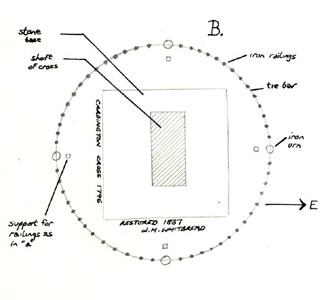Cardington Cross

Cardington Cross Christmas Eve 2010
The original Cardington cross was probably medieval in origin but the current cross dates from 1837. Volume III of The Victoria County History for Bedfordshire, published in 1912 (page 234) says: “South of Cardington Mill is Cardington Cross, erected in 1837 by William Henry Whitbread. An earlier one, dating from 1796, of which the octagonal base and part of the shaft are still to be seen, formerly stood in the corner of a field between the two Bedford roads”. In fact prints of this 1796 cross show a square base. This base may, in modified shape, form the base of the current cross, and so the octagonal base must have belonged to the earliest, probably medieval, cross. The octagonal base and a stump of shaft now stands next to the modern cross.
The cross is mentioned in a deed of 1761 [W741], the property being conveyed being described as a cottage near Fenlake Cross. The diary of Great Barford farmer John Pedley stated that on 3rd January 1784 there was a flood at Castle Mill Brook and a traveller was forced to come home by “the New Road by Cardington Cross in the night” [X141/3]. John Byng, 5th Viscount Torrington described a journey to Bedford on 18th June 1791: “At the end of Cardington where several roads join, stand the remains of an old cross”.
This old cross was replaced in 1796 and a drawing was sent to The Gentleman’s Magazine and published in March 1797. The drawing below [Z48/65] shows open country in the background, perhaps looking towards Harrowden. The cross itself has a decidedly Teutonic look. A letter by W. Parslow accompanying the drawing read: “Inclosed I send you a drawing of Cardington Cross, Bedfordshire which is much admired for its elegance. It was erected in the course of last year at the expence [sic] of the late Samuel Whitbread, esquire and is situated in the centre of three roads leading to Bedford, Saint Neots and Cardington”.
![The Cardington Cross of 1796 [Z48/65]](/CommunityHistories/Bedford/BedfordImages/The Cardington Cross of 1796 [Z48-65].jpg)
The Cardington Cross of 1796 [Z48/65]
The cross had distances to various towns inscribed on it as mentioned in a document of 1818 [BC514/1]:
West Side: Cardington ½ a mile
Cople 2
Northill 5
Old Warden 7
South Side: Willington 2
Barford 4
Eaton 9
St Neots 10
Cambridge 28
Biggleswade 8
East Side: The Barns ½
St. Mary’s Church 2
Newport Pagnell 15
Wellingborough 20
Kettering 27
Northampton 27
North Side: Bedford 2
Ampthill 9
Woburn 16
Oxford 58
“The remains of the old cross lies about 30 yards West of the new one”
This cross stood for only just over forty years before being replaced in 1837. Perhaps it was done to somehow commemorate the coronation of Queen Victoria, though there is no evidence of this.
Bedford architect James Tacy Wing wrote to Thomas Barnard of Cople House in 1876 [BD1261]: “The original stood by the side of the highway which was in the hollow, the remains of which, as well as the base of the Cross and broken shaft may now be seen. When the New Road was made, the trees planted and Bridge built by Samuel Whitbread, esquire, a new Cross in the modern style was erected at the intersection of the new Road about 1780. The situation of this being inconvenient, a new Cross, after the ancient form, was presented by Mr. Chantry and erected by WHW [William Henry Whitbread]. There was formerly a Cross in almost every village and market town, where public meetings were held and proclamations read; it was either in the Churchyard, or at a point where several roads met, or in some other conspicuous situation”. Wing’s date of 1780 is obviously a mistake. The Chantry mentioned was Sir Francis Chantrey, a well known sculptor and it is more likely that he carved and erected the new cross which was presented by William Henry Whitbread.

A drawing of the railings around Cardington Cross in 1978
On 9th November 1978 former County Archivist Chris Pickford made a sketch of the railing which then surrounded the cross [see above] together with a plan of the site [see below]. The base had an inscription on the west side: CARDINGTON CROSS 1796 and on the south side: RESTORED 1837 W. H. WHITBREAD.
 Plan of Cardington Cross in 1978
Plan of Cardington Cross in 1978